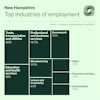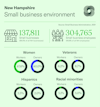 Stephanie Ferguson Melhorn
Stephanie Ferguson Melhorn
Executive Director, Workforce & International Labor Policy, U.S. Chamber of Commerce
Published
September 15, 2023
The state of New Hampshire has a favorable landscape for businesses and individuals, with a diverse economy, strong labor market recovery, and a robust small business ecosystem. Educational attainment, quality of life, and income-based factors remain promising.
The Chamber’s Worker Shortage Index ratio indicates the number of available workers for every job opening. A ratio above 1.0 indicates a surplus of available workers compared to job openings.
New Hampshire’s Labor Market
Prior to the pandemic, New Hampshire’s labor market was relatively healthy. While the state only had 75 workers per 100 jobs, the state's unemployment rate stood well below the national figure of 3.5%. It's labor force participation rate was higher than the national rate of 63.4%.
As of August 2023, New Hampshire’s labor market had not yet fully recovered, but is displaying signs of improvement. While the state's labor force participation rate still lags behind its pre-pandemic levels, it still stands above the national average. New Hampshire’s unemployment rate is significantly lower than it was before the pandemic.
On the downside, New Hampshire is heavily grappling with a severe workforce shortage, evident by the fact that there are only 28 available workers for every 100 open job positions in the state.
New Hampshire’s Business Environment
New Hampshire's business environment is diverse, encompassing a robust manufacturing sector, the largest legislative body in the nation, prestigious universities, and a thriving retail market.

Among the industries monitored by the Bureau of Labor Statistics, the trade, transportation, and utilities sector, as well as the education and health services sector, employ the highest number of New Hampshirites, while the construction sector employs the fewest. New Hampshire’s employment landscape comes from its multiple apparel and fashion companies, in addition to the numerous private and public universities within the state.
New Hampshire boasts a thriving small business ecosystem, with 99% of all New Hampshire businesses falling into this category. Nearly half of New Hampshire's workforce works within small businesses. Within this dynamic landscape, women own 40% of small businesses, 3% are minority-owned, 2% are owned by Hispanics, and 8.7% are veteran-owned.

New Hampshire’s Educational Attainment

Nearly 95% of New Hampshire’s population has obtained their high school diploma or its equivalent, five percentage points above the national average in 2022. 41.3% of the population have attained a bachelor's degree, while 16.7% have secured a graduate degree, both above the national average.

Slightly less than half of incoming college freshmen are remaining in the state for their higher education, where the average in-state tuition is $16,679. Out-of-state tuition in the Granite state is $30,594, slightly more expensive than the national average out-of-state tuition of $28,000. Roughly 198,000 students are enrolled in a New Hampshire college for the 2022-2023 school year. These students supply a rich talent pool from which local employers can recruit talent.
Quality of Life

New Hampshire has a median household income of $84,970, surpassing the national median average of approximately $70,000. This positions the state at 15th place among all states, although it experienced a significant decline in the past year. New Hampshire maintains a modest tax rate of 5%, employing a flat-rate structure that exclusively taxes income. This places it among the states with comparatively lower tax rates.
One-third of New Hampshire’s workforce work remote at least one day a week. For those commuting into an office, the average commute time is 27.1 minutes. The Council for Community and Economic Research measures states’ costs of living compared to the national average of 100. New Hampshire’s cost of living index falls at 115, meaning the state is less affordable in comparison to the national cost of living. The median rent settles at $1,145, while the median home cost is $467,775, both above the national average. Nearly 71.6% of the population owned their housing unit in 2021. The state experienced a growth rate of 1.21% from 2020 to 2022.
Immigration

In the U.S., immigrants tend to be of working age in comparison to native-born individuals. As workers, these immigrants are also contributing to support programs like Medicare and Social Security.
Looking at New Hampshire in particular, immigrants comprise 6.4% of the state's population, totaling 87,055 individuals. Their collective spending power amounts to one billion dollars, while their tax contributions reach $3.1 billion.
Explore More States
About the authors

Makinizi Hoover
Makinizi Hoover is Housing Policy Lead at the U.S. Chamber of Commerce, where she leads the Chamber’s work to advance supply-side reforms that improve housing affordability and availability.

Stephanie Ferguson Melhorn
Stephanie Ferguson Melhorn is the Executive Director, Workforce and International Labor Policy. Her work on the labor shortage has been cited in the Wall Street Journal, Washington Post, and Associated Press.

Isabella Lucy
Isabella has created stunning visualizations tackling pressing issues like the worker shortage, the benefits of hiring veterans, the lifespan of small businesses, and the future of work.





